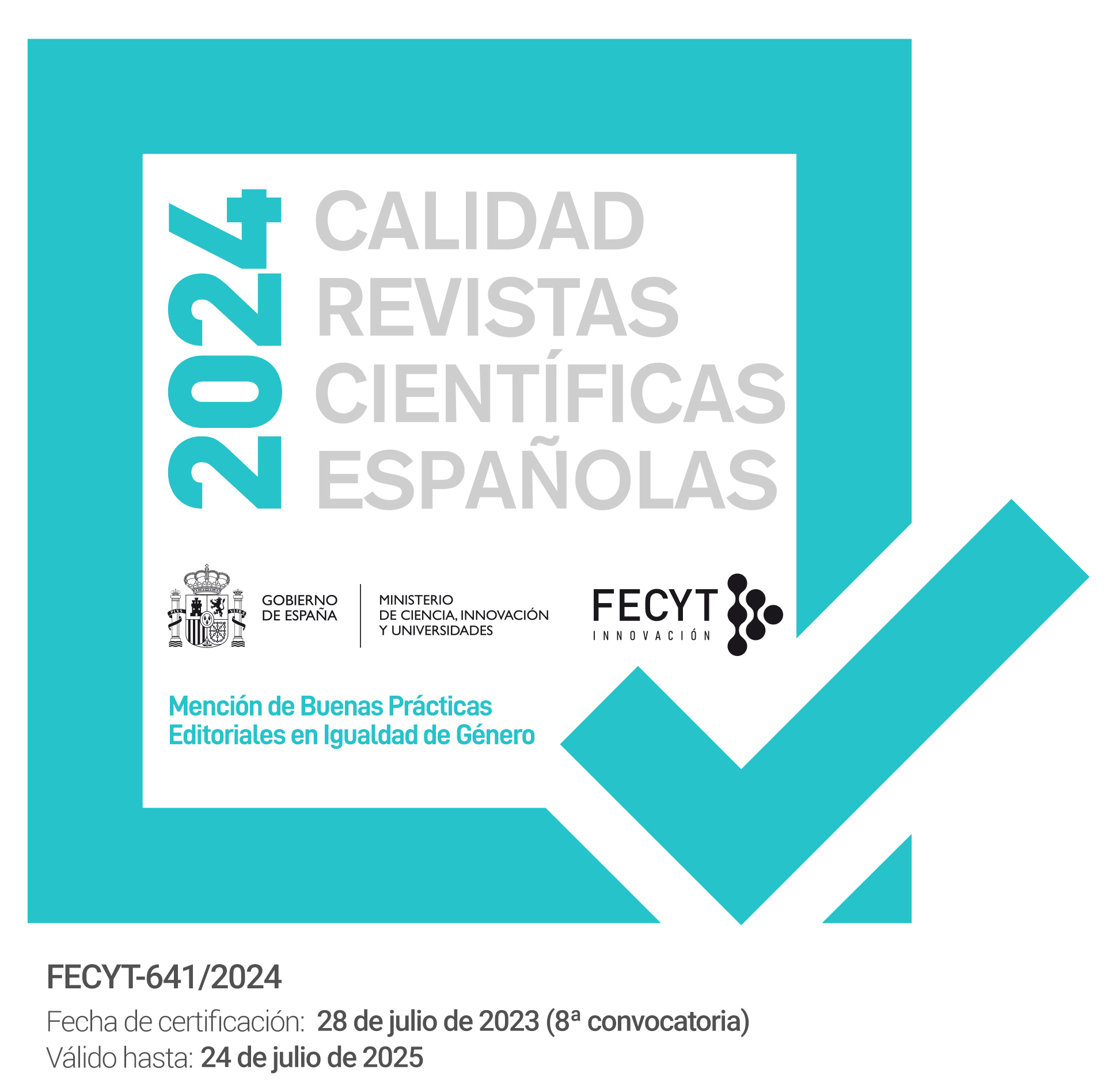El estudio de los tópicos literarios como área de la literatura comparada: el caso del “asesinato por amor”
DOI:
https://doi.org/10.12795/PH.2022.v36.i02.10Palabras clave:
tópicos literarios, literatura comparada, recepción clásica, Eugene O’Neill, asesinato por amorResumen
Este artículo tiene como objetivo examinar la posición de los tópicos literarios en el campo de la literatura comparada partiendo de la definición de los tópicos literarios de Escobar (2000) y Laguna Mariscal (1999). Uno de los requisitos para distinguir un tópico de términos literarios similares es su recurrencia en la historia literaria desde la tradición clásica hacia la literatura moderna. En consecuencia, el estudio de los tópicos literarios siempre implica evolución, desarrollo y comparación. Para mostrar esto en la práctica, presentamos el “asesinato por amor” como un tópico literario y analizamos su desarrollo en las tragedias de Eugene O’Neill Deseo bajo los olmos (1924) y A Electra le sienta bien el luto (1931). Los resultados del estudio validan la necesidad de la comparación (en el sentido de buscar estructuras o sintaxis paralelas) al examinar los tópicos literarios. En consecuencia, al analizar el desarrollo del “asesinato por amor” en las obras de O’Neill, es fundamental rastrear sus relaciones architextuales con los textos clásicos, como las narraciones de Medea.
Descargas
Referencias bibliográficas
Aguiar E Silva, V. M. de. (1972). Teoría de la literatura. Gredos.
Alexander, D. (1953). Psychological Fate in Mourning Becomes Electra. PMLA, 68(5), 923-934.
Altenburger, R. (2009). The Sword or the Needle: The Female Knight-errant (xia) in Traditional Chinese Narrative. Peter Lang.
Asselineau, R. (1958). Mourning Becomes Electra as a Tragedy. Modern Drama, 1(3), 143-150.
Bigsby, C. (2018). Forward, in D. Palmer (Ed.), Visions of Tragedy in Modern American Drama (pp. xvi-xx). Bloomsbury.
Black, S. A. (2004). ‘Mourning Becomes Electra’ as a Greek Tragedy. The Eugene O’Neill Review, 26, 166-188.
_______ (2005). ‘Mourning Becomes Electra’ at 74. The Eugene O’Neill Review, 27, 115-125.
Bloom, C. (1995). American Drama. St. Martin’s Press.
Bloom, S. F. (2014). Eugene O’Neill. In J. H. Richards and H. S. Nathans (Eds.), The Oxford Handbook of American Drama (pp. 248-263). Oxford University Press.
Bran, G. (1999). Eugene O’Neill. In F. N. Magill (Ed.), The 20th Century O-Z: Dictionary of World Biography (pp. 2819-2823). Routledge.
Bremmer, J. N. (1997). Why Did Medea Kill Her Brother Apsyrtus? In J. J. Clauss and S. I. Johnston (Eds.), Medea: Essays on Medea in Myth, Literature, Philosophy, and Art (pp. 83-102). Princeton University Press.
Brietzke, Z. (2001). The Aesthetics of Failure: Dynamic Structure in the Plays of Eugene O’Neill. McFarland & Company, Inc. Publishers.
Bryer, J. R. & Hartig, M. C. (2010). The Facts on File Companion to American Drama. Facts on File, Inc.
Cao, S. (2013). The Variation Theory of Comparative Literature. Springer.
Curtius, E. R. (1983). European Literature and the Latin Middle Ages (W. R. Trask, trans.). Princeton University Press.
Diggins, J. P. (2007). Eugene O’Neill’s America: Desire under Democracy. The University of Chicago Press.
Dixon-Kennedy, M. (1998). Encyclopedia of Greco-Roman Mythology. ABC-CLIO, Inc.
Domínguez, C., Saussy, H. & Villanueva, D. (2015). Introducing Comparative Literature: New Trends and Applications. Routledge.
Dowling, R. M. (2009). Critical Companion to Eugene O’Neill: A Literary Reference to His Life and Work. Facts on File.
Dubost, T. (2019). Eugene O’Neill and the Reinvention of Theatre Aesthetics. McFarland & Company, Inc.
Edinger, E. F. (1994). The Eternal Drama: The Inner Meaning of Greek Mythology. Shambhala Publications, Inc.
Elstein, Y. & Lipsker, A. (1995). The Homogeneous Series in the Literature of the Jewish People: A Thematological Methodology. In F. Trommler (Ed.), Thematics Reconsidered: Essays in Honor of Horst S. Daemmrich (pp. 87-116). Rodopi.
Escobar, Á. (2019). Fortitudo and sapientia: A Literary Motif in Medieval Hispano-Latin Chronicles and in Spanish Epic Poetry. RILCE, 35(2), 461-77.
_______ (2018). El tópico de lugar o argumentum a loco en la épica española y en las crónicas hispanolatinas medievales. En M. Morrás (Ed.), Espacios en la Edad Media y el Renacimiento (pp. 413-424). SEMYR.
_______ (2006). El tópico literario como forma de tropo: definición y aplicación. Cuadernos de Filología Clásica: Estudios Latinos, 26, 15-24.
_______ (2000). Hacia una definición lingüística del tópico literario. Myrtia, 15, 123-160.
Euripides. (1994). Medea. In D. Kovacs (trans. & ed.). Cyclops, Alcestis, Medea (pp. 285-427). Harvard University Press.
Fischer-Lichte, E. (2004). History of European Drama and Theatre. Routledge.
Franco, C. (2014). Shameless: The Canine and the Feminine in Ancient Greece. University of California Press.
Gaycken, H. B. (1976). A Comparative Study of Topoi in Germanic and Romance Medieval Literature [PhD dissertation], The University of Tennessee.
Genette, G. (1997a). Palimpsests: Literature in the Second Degree (C. Newman & C. Doubinsky, trans.). University of Nebraska Press.
_______ (1997b). Paratexts: Thresholds of Interpretation (J. E. Lewin, trans.). Cambridge University Press.
Gómez Luque, J. A. (2018). The Literary Topos of Love Seafare: from Classical Literature to Spanish Poetry of the Golden Age [PhD dissertation], University of Cordoba.
Grafton, A., Most, G. W. & Settis, S. (2010). The Classical Tradition. The Belknap Press of Harvard University Press.
Gray, R. (2012). A History of American Literature. Blackwell Publishers Ltd.
Greene, T. M. (1982). The Light in Troy. Imitation and Discovery in Renaissance Poetry. Yale University Press.
Gupta, T. & Mahal, R. (2014). Inheritance and Infanticide in Eugene O’Neill’s Desire Under the Elms. Research Scholar: An International Refereed e-Journal of Literary Explorations, 2(3), 196-211.
Hays, P. (1969). Biblical Perversions in Desire Under the Elms. Modern Drama, 11(4), 423-428.
Hermann, S. (2017). Reading and Interpreting the Works of Eugene O’Neill. Enslow Publishing, LLC.
Highet, G. (1951). The Classical Tradition: Greek and Roman Influences on Western Literature. Oxford University Press.
Kabatchnik, A. (2010). Blood on the Stage, 1925-1950: Milestone Plays of Crime, Mystery, and Detection: An Annotated Repertoire. The Scarecrow Press, Inc.
Kidd, M. (1999). Stages of Desire: The Mythological Tradition in Classical and Contemporary Spanish Theatre. The Pennsylvania State University Press.
Khare, R. R. (1998). Shakespeare, Eugene O’Neill, T.S. Eliot and the Greek Tragedy. Mittal Publications.
Laguna Mariscal, G. (2019). Ghosts of girlfriends past: development of a literary episode. In D. Romero-González, I. Muñoz-Gallarte & G. Laguna-Mariscal (Eds.), Visitors from beyond the Grave: Ghosts in World Literature (pp. 123-138). Coimbra University Press.
_______ (2014). Regalos para enamorar (munera amoris): un tópico literario de ayer y de hoy. En R. Moreno Soldevila y J. Martos (Eds.), Amor y sexo en Roma: su reflejo en la literatura (pp. 25-56). Universidad de Huelva.
_______ (2013). Eres mi padre y mi madre: tradición literaria de un tópico amatorio atribuido a Jesús en el Evangelio. En L. Roig Lanzillota e I. Muñoz Gallarte (Eds.), Liber amicorum en honor del Profesor Jesús Peláez del Rosal (pp. 207-217). Ediciones El Almendro.
_______ (2011). Riñas. En R. Moreno Soldevila (Ed.), Diccionario de motivos amatorios en la Literatura Latina: Siglos III a. C.-II d. C. (pp. 366-369). Universidad de Huelva.
_______ (1999). En tierra, en humo, en polvo, en sombra, en nada: historia de un tópico literario. Anuario de Estudios Filológicos, 22, 197-213.
_______ (1994). Literatura comparada y tradición clásica: Quevedo y sus fuentes clásicas. Anuario de Estudios Filológicos, 17, 283-294.
Lambropoulos, V. (2015). Eugene O’Neill’s Quest for Greek Tragedy. In K. Bosher, F. Macintosh, J. McConnell & P. Rankine (Eds.), The Oxford Handbook of Greek Drama in the Americas. Oxford University Press.
Leeman, A. D. (1982). The lonely vigil. A topos in ancient literature. In J. den Boeft & A. H. M. Kessels (Eds.), Actus: Studies in honour of H. L. W. Nelson (pp. 189-201). Instituut voor Klassieke Talen.
Liapis, V. (2021). Prelude: Adapting Greek Tragedy: A Historical Perspective. In V. Liapis & A. Sidiropoulou (Eds.), Adapting Greek Tragedy: Contemporary Contexts for Ancient Texts. Cambridge University Press.
Librán Moreno, M. (2011). Muerte y amor. En R. Moreno Soldevila (Ed.), Diccionario de motivos amatorios en la Literatura Latina: Siglos III a. C.-II d. C. (pp. 287-290). Universidad de Huelva.
López Gregoris, R. (2021). Tematología. En F. García Jurado (Ed.), Diccionario Hispánico de la Tradición y Recepción Clásica (pp. 707-715). Guillermo Escolar Editor S. L.
López Martínez, M. I. (2007). El tópico literario: teoría y crítica. Arco/Libros, S. L.
_______ (1990). Tierra madre y hombre de barro: ‘topoi’ en la poesía de Vicente Aleixandre. Anuario de estudios filológicos, 13, 167-184.
Madran, C. Y. (2006). The Ambivalence of Love and Hate in Desire Under the Elms: A Psychological and Mythological Approach. The Journal of Selcuk University Social Sciences Institute, 16, 449-458.
Mahfouz, S. M. (2010). Tragic Passion, Romantic Eloquence, and Betrayal in Eugene O’Neill’s Desire Under the Elms. Studies in Literature and Language, 1(3), 1-15.
Majumdar, R. G. (2016). Laying Ella’s Ghost: Sublimation of Incestuous Love in Eugene O’Neill’s Desire under the Elms and A Moon for the Misbegotten. The Eugene O’Neill Review, 37(1), 41-56.
Maleki, N., Nazemi, Z. & Laguna Mariscal, G. (2020). The Scheme of Potiphar’s Wife: From Classical Tradition to Eugene O’Neill. Revista de Estudios Norteamericanos, 24, 113-134.
McDonald, M. (2003). The Living Art of Greek Tragedy. Indiana University Press.
McEvoy, S. (2017). Tragedy: The Basics. Routledge.
Márquez, M. Á. (2002). Tema, Motivo y Tópico. Una Propuesta Terminológica. Exemplaria, 6, 251-256.
Narey, W. (1992). Eugene O’Neill’s Attic Spirit: Desire Under the Elms. The Eugene O’Neill Review, 16(1), 49-54.
Naupert, C. (2001). La tematología comparatista: entre teoría y práctica. Arco/Libros.
Nazemi, Z. (2022). El amor no correspondido en las tragedias de Eugene O’Neill. En Actas del X Congreso Científico de investigadores en Formación de la Universidad de Córdoba: El arte de investigar (pp. 99-101). UCO Press.
Nazemi, Z. y Laguna Mariscal, G. (2022). Eugene O’Neill: la tragedia clásica en versión moderna. The Conversation (Spain), https://theconversation.com/eugene-oneill-la-tragedia-clasica-en-version-moderna-182018.
Nazemi, Z., Maleki, N. & Laguna Mariscal, G. (2022). New Insights into Literary Topoi: A Study of ‘Madness for Guilt and Remorse’. Anuario de Estudios Filológicos, 45, 193-210.
Neerudu, V. (2020). Vain Hopes of the Human Race in Eugene O’Neill’s Plays. Lulu Press, Inc.
Newlands, C. E. (1997). The Metamorphosis of Ovid’s Medea. In J. J. Clauss & S. I. Johnston (Eds.), Medea: Essays on Medea in Myth, Literature, Philosophy, and Art (pp. 178-210). Princeton University Press.
Nugent, S. G. (2014). Passion and Progress in Ovid’s Metamorphoses. In J. T. Fitzgerald (Ed.), Passions and Moral Progress in Greco-Roman Thought (pp. 153-174). Routledge.
Nussbaum, M. C. (1994). The Therapy of Desire: Theory and Practice in Hellenistic Ethics. Princeton University Press.
O’Neill, E. (1988a). Desire Under the Elms. In Bogard, T. (Ed.), Complete Plays 1920-1931 (pp. 317-378). The Library of America.
_______ (1988b). Mourning Becomes Electra. In Bogard, T. (Ed.), Complete Plays 1920-1931 (pp. 877-1054). The Library of America.
Ovid. (1892). Metamorphoses (H. Magnus, ed. & trans.). Gotha.
_______ (1939). Tristia (A. Leslie Wheeler, trans.). Harvard University Press.
Piquer, A. (2020). The Ages of Phaedra: Literature and Context. In V. Salvador & A. Sampietro (Eds.), Understanding the Discourse of Aging: A Multifaceted Perspective (pp. 107-130). Cambridge Scholars Publishing.
Práce, B. (2012). Vertiginous Relations in Eugene O’Neill’s Desire Under the Elms & Mourning Becomes Electra [Bachelor thesis, Charles University of Prague].
Raleigh, J. H. (1989). Strindberg and O’Neill as Historical Dramatists. In M. Maufort (Ed.), Eugene O’Neill and the Emergence of American Drama (pp. 59-76). Rodopi.
Robinson, J. A. (1998). The middle plays. In M. Manheim (Ed.), The Cambridge Companion to Eugene O’Neill (pp. 69-81). Cambridge University Press.
Sanders, T. A. (1968). The Discovery of Drama. Scott Foresman.
Scheaffer, L. (2002). O’Neill: Son and Artist. Cooper Square Press.
Scholz, B. F. (1986). Practical Justification in Literary Scholarship. In H. Remak (Ed.), Sensus Communis: Contemporary Trends in Comparative Literature (pp. 167-181). Gunter Narr Verlag.
Seigneuret, J. C. (1988). Dictionary of Literary Themes and Motifs, Vol. 1. Greenwood Publishing Group.
Singh, B. (2016). Three Tragedies. Lulu Press, Inc.
Sinha, M. (2021). Literary Influence: A Pivotal Aspect in the Domain of Comparative Literature. PJAEE, 18(4), 5267-5272.
Thorburn, J. E. (2005). The Facts on File Companion to Classical Drama. Facts on File, Inc.
Thornton, B. C. (1997). Eros: The Myth of Ancient Greek Sexuality. Westview Press.
Törnqvist, E. (2004). Eugene O’Neill: A Playwright’s Theatre. McFarland & Company, Inc., Publishers.
Valpy, A. J. (1821). Elements of Mythology: Intended to Enable the Reader to Understand the Ancient Writers of Greece and Rome. Clarks & Raser.
Virgil. (1900). Bucolics, Aeneid, and Georgics of Vergil (J. B. Greenough, trans.). Ginn & Co.
Williams. R. (1966). Modern Tragedy. Stanford University Press.
Wong, E. (2019). The Risk Theatre Model of Tragedy: Gambling, Drama, and the Unexpected. Friesen Press.
Descargas
Publicado
Cómo citar
Número
Sección
Licencia
Derechos de autor 2022 Zahra Nazemi

Esta obra está bajo una licencia internacional Creative Commons Atribución-SinDerivadas 4.0.
Las ediciones impresa y electrónica de esta Revista son editadas por la Editorial Universidad de Sevilla, siendo necesario citar la procedencia en cualquier reproducción parcial o total.
Salvo indicación contraria, todos los contenidos de la edición electrónica se distribuyen bajo una licencia de uso y distribución “Creative Commons Atribución-NoComercial-SinDerivar 4.0 Internacional” ![]() . Puede consultar desde aquí la versión informativa y el texto legal de la licencia. Esta circunstancia ha de hacerse constar expresamente de esta forma cuando sea necesario.
. Puede consultar desde aquí la versión informativa y el texto legal de la licencia. Esta circunstancia ha de hacerse constar expresamente de esta forma cuando sea necesario.
Los autores/as que publiquen en esta revista aceptan las siguientes condiciones:
- Los autores/as conservan los derechos de autor y ceden a la revista el derecho de la primera publicación, y consienten en que se distribuya con una licencia Creative Commons By NC ND 4.0, que permite a terceros utilizar lo publicado siempre que mencionen la autoría del trabajo y a la primera publicación en esta revista, no se haga uso comercial y se reutilice de igual forma."
- Los autores/as pueden realizar otros acuerdos contractuales independientes y adicionales para la distribución no exclusiva de la versión del artículo publicado en esta revista (p. ej., incluirlo en un repositorio institucional o publicarlo en un libro) siempre que indiquen claramente que el trabajo se publicó por primera vez en esta revista.
- Se permite y recomienda a los autores/as que una vez publicado el artículo en la revista Philologia Hispalensis (versión online) se descarguen el PDF correspondiente y lo difundan por internet (ResearchGate, Academia.edu, etc.) ya que puede conducir a intercambios científicos productivos y a una mayor y más rápida difusión del trabajo publicado (vea The Effect of Open Access).
Aceptado 2022-07-04
Publicado 2022-12-12
- Resumen 485
- PDF (English) 533
- HTML 66
- XML (English) 55








